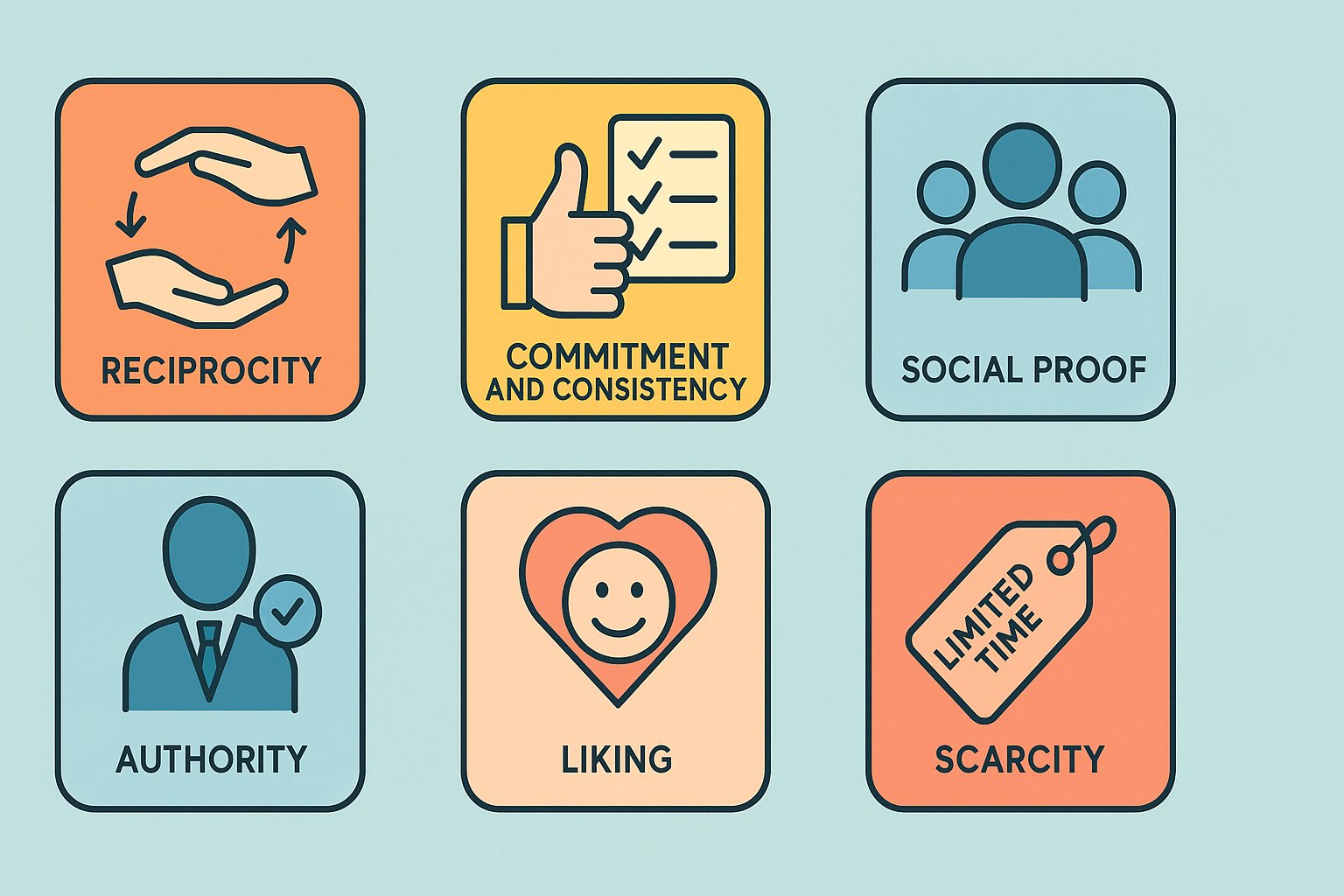Apr22

Below we explore each principle and provide a real-world example of a global brand’s loyalty program that illustrates how that principle is embedded in the program’s design or communication, ultimately driving customer engagement and loyalty. Each section highlights specific features of the program and why they work, across points-based rewards, paid memberships, and gamified loyalty systems.
Sephora’s Beauty Insider loyalty program offers free birthday gift sets or bonus points to members, exemplifying the principle of giving first to build goodwill.
The reciprocity principle is about returning favors – people feel obliged to reciprocate when they receive an unexpected gift or kindness
Loyalty programs leverage this by giving members rewards “on the house”, fostering goodwill that customers return with repeat business. A great example is Sephora’s Beauty Insider program (a free, points-based loyalty program for the beauty retailer). Sephora showers its members with “surprise and delight” perks – notably a free birthday gift each year for every member, no purchase necessary. This personalized, unexpected gift makes members feel valued and creates a subconscious sense of obligation or desire to “give back” by shopping at Sephora. It strengthens the emotional connection between the customer and the brand, which increases loyalty and lifetime value
By giving benefits first, Sephora’s program makes customers feel appreciated. This not only encourages them to reciprocate with repeat purchases, but also differentiates the loyalty program as customer-centric. The result is a win-win: members enjoy free gifts and special treatment, and Sephora enjoys increased customer loyalty and spending as a return favour
The commitment and consistency principle says that once people commit to something, they tend to stick with it to be consistent with their initial decision. Loyalty programs take advantage of this by securing an upfront commitment from customers – even a small one – and then building on it. A prime example is the Amazon Prime membership program. Amazon Prime is a paid loyalty program (members pay an annual fee for a suite of benefits), and it masterfully locks in customer commitment, leading to very consistent, loyal purchase behavior. How Amazon Prime uses this principle:
Upfront Membership Commitment: Prime requires customers to pay an annual fee (or monthly fee) to join. This is a deliberate commitment. Psychologically, once you’ve paid for Prime, you want to justify that expense by using Amazon as much as possible. Prime members end up shopping far more frequently on Amazon to “get their money’s worth,” which is exactly the consistency effect. In fact, once they’ve paid, Prime members actively prefer to buy on Amazon (free shipping, etc.) rather than elsewhere, to stay consistent with the commitment they made. This two-way commitment is powerful – as one analysis noted, “Amazon Prime members want to make additional purchases to justify the membership cost.”
Amazon Prime’s loyalty effect illustrates commitment & consistency in action. By getting that upfront commitment (even though it’s paid), Amazon secures “truly committed” customers. Those customers then consistently choose Amazon for purchases to stay aligned with their commitment – driving significantly higher purchase frequency and spend. The commitment principle is so strong that it transforms behavior: Prime members become loyal by identity (“I am a Prime member”), ensuring long-term engagement.
Humans tend to look at what others are doing when making decisions – this is the social proof principle. If a loyalty program is extremely popular and heavily used by people around us, we’re more likely to join and participate, assuming it must be valuable. Brands capitalize on this by publicizing their loyalty programs’ popularity and creating community features that show many peers engaging. A clear illustration is Marriott Bonvoy, the global hotel loyalty program of Marriott. Bonvoy is one of the largest loyalty programs in the world, and Marriott leverages its huge membership base as a selling point to attract and reassure customers. Here’s how social proof plays out in Marriott’s program:
Massive Membership Numbers: Marriott frequently shares the impressive size of its loyalty program. As of 2024, Marriott Bonvoy had over 200 million members worldwide – making it one of the largest (if not the largest) loyalty programs in any industry. This sheer number signals to potential members that “everyone else is in Bonvoy.” Seeing that hundreds of millions of fellow travelers have joined creates a powerful social proof: if so many people find it worthwhile, new customers infer that they should join too, so as not to be left out. (Indeed, Marriott’s CEO emphasizes the program’s size as a strength in engagement.)
Community and Sharing: Marriott Bonvoy also fosters a sense of community by encouraging members to share their experiences. On social media, Marriott highlights user-generated content from members, and members often tout their status level or points-earned stories in travel forums. This public visibility of loyalty (people proudly saying “I used my Bonvoy points for a free night!”) acts as social proof to others who follow travel communities. Additionally, referrals by word-of-mouth from millions of existing members bring in new members who don’t want to miss out on what friends and family are enjoying.
By emphasizing how popular and widely used the program is, Marriott uses social proof to its advantage.
The authority principle means people are persuaded by experts or authoritative endorsements – we tend to trust and follow the recommendations of credible, knowledgeable sources. In loyalty programs, this principle is leveraged when a program is backed by experts, awards, or a reputation for excellence, giving customers confidence that joining the program is a smart, safe choice. Hilton Honors, the global hotel loyalty program of Hilton, exemplifies this: Hilton uses its industry awards and expert rankings to convey authority and persuade customers of its program’s value. Here’s how Hilton Honors embeds authority:
“Best Loyalty Program” Accolades: Hilton Honors has consistently been rated as a top loyalty program by industry authorities. For instance, it won The Points Guy’s “Best Hotel Loyalty Program” award and was ranked the #1 Hotel Loyalty Scheme by Business Traveller. It’s also frequently atop expert rankings (e.g. named “Best Hotel Rewards Program” in various travel magazines and by frequent travelers). Hilton proudly showcases these honors. By advertising that travel experts and award panels have given Hilton Honors the highest marks, the brand signals to customers that this is an authoritative program to join. The implicit message: “Experts agree Hilton Honors is the best,” which builds trust in prospective members’ minds (people think if authorities say it’s the best, it probably is).
Expert Design of Benefits: Authority can also come from how the program is structured. Hilton Honors, for instance, provides benefits that align with expert traveler advice (e.g., generous late checkout, free breakfast for elite members – perks travel bloggers and consultants often recommend as valuable). By incorporating features that industry experts praise, Hilton’s program feels well-designed by professionals, further enhancing its authority. Additionally, partnerships with other trusted brands (airlines, credit cards like American Express) lend authority by association – if Hilton Honors is the chosen partner of these respected companies, it must be reputable.
In essence, Hilton Honors uses authority signals to reassure and attract customers.
The liking principle asserts that people are more likely to be influenced by people (or brands) that they like, find attractive, or feel connected to
In loyalty programs, fostering a positive emotional relationship – through brand personality, personal interactions, or community belonging – can enhance loyalty beyond the rational perks. Customers stick with programs (and companies) that they have warm feelings toward. Harley-Davidson’s Harley Owners Group (H.O.G.) is a standout example where the loyalty “program” is essentially a community built on genuine affinity. H.O.G. is a global club for Harley-Davidson owners, and it uses the liking principle by turning customers into a tight-knit group of friends who share a passion. This drives extraordinary loyalty. Key aspects of H.O.G. and the liking principle: Harley-Davidson’s H.O.G. (Harley Owners Group) rallies and rides bring together a community of riders who share a love of the brand. The camaraderie and lifestyle appeal foster strong bonds (liking) that translate into loyalty.
Brand Community and Camaraderie: H.O.G. is far more than a typical points program – it’s a community experience. With over one million members worldwide and 1,400+ local chapters, it creates instant camaraderie among Harley owners. Members frequently gather for group rides, rallies, and events, forming friendships around their shared hobby. This sense of belonging fulfills a social need – members like each other and have fun together, which in turn makes them love the Harley-Davidson brand even more. As one rider put it, “I wanted to hang out with the Harley crowd… it’s easy to like the freedom Harleys convey.”
By embedding the brand in a enjoyable social context, H.O.G. makes the act of brand loyalty an enjoyable, likable experience in itself.
Through H.O.G., Harley-Davidson demonstrates that loyalty can be driven by friendship and affinity.
The scarcity principle hinges on the idea that people place higher value on things that are scarce or hard to get. In marketing, limited-time offers or exclusive items create a sense of urgency and specialness that spurs people to act. Loyalty programs cleverly use scarcity by giving their members access to deals or products that are not available to everyone or only available for a short window, thereby motivating customers to engage so they don’t miss out (a bit of FOMO). Nike’s membership program provides a clear example of leveraging scarcity. Nike’s program (free to join via Nike app and the SNKRS app) doesn’t use points; instead, it focuses on exclusive access and experiences for members – many of which are scarce by nature. Here’s how Nike applies scarcity in its loyalty/engagement program:
Limited-Edition Product Access: Nike rewards its loyal members by giving them “privileged access to new and limited-edition products.” Members often enjoy early access to sneaker releases or members-only product drops. For example, a much-hyped Air Jordan collaboration might be made available on the SNKRS app only to certain members with Exclusive Access, or to all members a few hours before the general public. These coveted sneakers typically sell out, so the chance to buy one is genuinely scarce. Knowing that only members get that shot at the limited sneaker drives countless sneaker enthusiasts to join Nike’s program and stay actively engaged (they’ll open the app when notified, participate in draws, etc.). Scarcity here creates excitement and urgency – members feel privileged and rush to act, which boosts Nike’s sales and app engagement.
Members-Only Offers and Content: Nike also provides members-only sales or events that occur for a limited time. For instance, a “Member Day” sale with a special discount on select items might run for 48 hours exclusively for Nike members. The short timeframe (scarcity of time) plus exclusivity (not open to non-members) prompts members to take advantage of the offer now, rather than delay. This drives immediate engagement and reinforces the habit of checking Nike’s member communications regularly (so you never miss a limited deal).
By making certain rewards exclusive or fleeting, Nike creates a sense of urgency and exclusivity that deeply engages its customers.
These real-world cases demonstrate that beyond points and perks, psychology is at the heart of loyalty program design – by appealing to reciprocity, commitment, social proof, authority, liking, and scarcity, brands create programs that not only reward customers, but also persuade them to engage and remain loyal in the long run
Keywords: CRM, Customer Experience, Customer Loyalty
 Cialdini’s Principles of Persuasion in Customer Loyalty Programs
Cialdini’s Principles of Persuasion in Customer Loyalty Programs Beyond the Framework: The Real Architecture of Ethical AI Governance
Beyond the Framework: The Real Architecture of Ethical AI Governance The Four Tests Every Strategy Should Pass
The Four Tests Every Strategy Should Pass Friday’s Change Reflection Quote - Leadership of Change -Leaders Enable Peaceful Dispute Resolution
Friday’s Change Reflection Quote - Leadership of Change -Leaders Enable Peaceful Dispute Resolution The Corix Partners Friday Reading List - April 18, 2025
The Corix Partners Friday Reading List - April 18, 2025